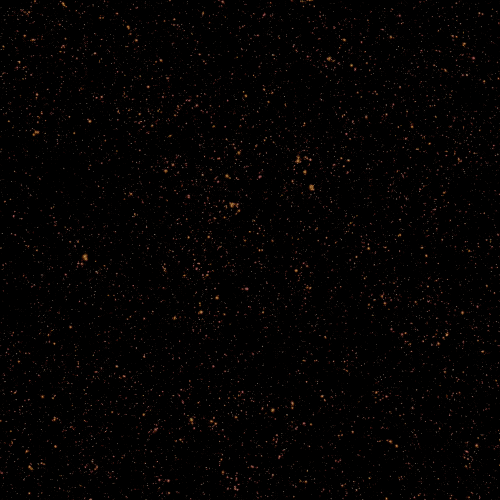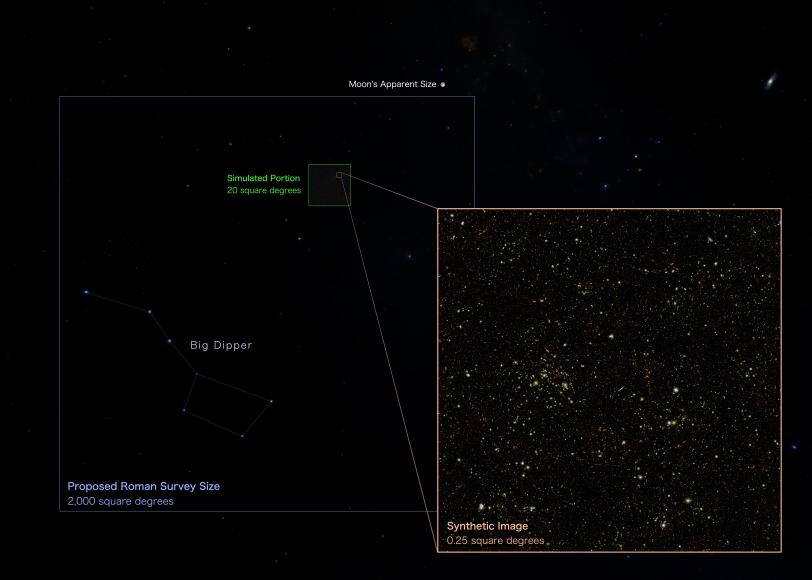Scientists have created a gargantuan synthetic survey that shows some of what we can expect from NASA's Nancy Grace Roman Space Telescope, slated to launch in the mid-2020s, and the Vera C. Rubin Observatory's Legacy Survey of Space and Time (LSST), funded by the National Science Foundation and the Department of Energy. Though it represents just a small chunk of the real future surveys, this simulated version contains a staggering number of galaxies - 33 million of them, along with 200,000 foreground stars in our home galaxy.
The team drew data from a mock universe originally developed to support science planning with the Vera C. Rubin Observatory, which is located in Chile and set to begin full operations in 2024, and the Rubin/LSST Dark Energy Science Collaboration. Because the Roman and Rubin/LSST simulations use the same source data, astronomers can compare them and see what they can expect to learn from pairing the telescopes' observations once they're both actively scanning the universe.
The work put in now will also help both teams make the most of the data they collect in the future. "The idea there was to use the same simulated data, so that downstream we can foster more collaboration," said James Chiang, a lead scientist at the Department of Energy's SLAC National Accelerator Laboratory and a researcher on the project. "I'm excited to work with everyone and see things come together."

A paper describing the results, led by Duke University assistant professor Michael Troxel, is published in Monthly Notices of the Royal Astronomical Society.
Cosmic Construction
Roman's High Latitude Wide Area Survey will consist of both spectroscopy and imaging, which is the focus of the new simulation. Roman's imaging will reveal precise positions and shapes of hundreds of millions of faint galaxies that will be used to map dark matter. That data - as well as data from Rubin and other projects - will in turn help researchers understand how the universe evolved into what we see today and fill in more of the gaps in our understanding of dark matter.
"Theories of cosmic structure formation make predictions for how the seed fluctuations in the early universe grow into the distribution of matter that can be seen through gravitational lensing," said Chris Hirata, a physics professor at Ohio State University in Columbus, and a co-author of the paper. "But the predictions are statistical in nature, so we test them by observing vast regions of the cosmos. Roman, with its wide field of view, will be optimized to efficiently survey the sky, complementing observatories such as the James Webb Space Telescope that are designed for deeper investigation of individual objects."

Ground and Space
The synthetic survey covers 20 square degrees of the sky, which is roughly equivalent to 95 full moons. The actual survey will be 100 times larger, unveiling more than a billion galaxies. Rubin will scan an even greater area - 18,000 square degrees, nearly half of the entire sky - but with lower resolution since it will have to peer through Earth's turbulent atmosphere.
Pairing the Roman and Rubin/LSST simulations offers the first opportunity for scientists to try to detect the same objects in both sets of images. That's important because ground-based observations aren't always sharp enough to distinguish multiple, close sources as separate objects. Sometimes they blur together, which affects weak lensing measurements. Now, scientists can determine the difficulties and benefits of "deblending" such objects in Rubin images by comparing them with Roman ones.
With Roman and Rubin's colossal cosmic view, astronomers will be able to accomplish far more than the survey's primary goals, which are to study the structure and evolution of the universe, map dark matter, and discern between the leading theories that attempt to explain why the expansion of the universe is speeding up. Scientists can comb through the new simulated data to get a taste of the bonus science that will come from seeing so much of the universe in such exquisite detail.
"We anticipate many different scientific opportunities, but we will also have to learn to expect the unexpected," said Julie McEnery, the senior project scientist for the Roman mission at NASA's Goddard Space Flight Center in Greenbelt, Maryland. "The mission will help answer critical questions in cosmology while potentially revealing brand new mysteries for us to solve."
The research was funded in part by the DOE Office of Science. Portions of the research were conducted at the National Energy Research Scientific Computing Center, a DOE Office of Science user facility.
This article is based on an article from NASA Goddard Space Flight Center.
Citation: M. A. Troxel et al., forthcoming in Monthly Notices of the Royal Astronomical Society.






